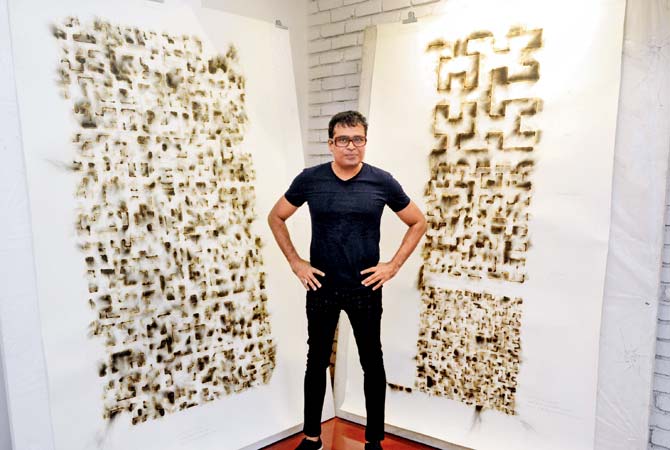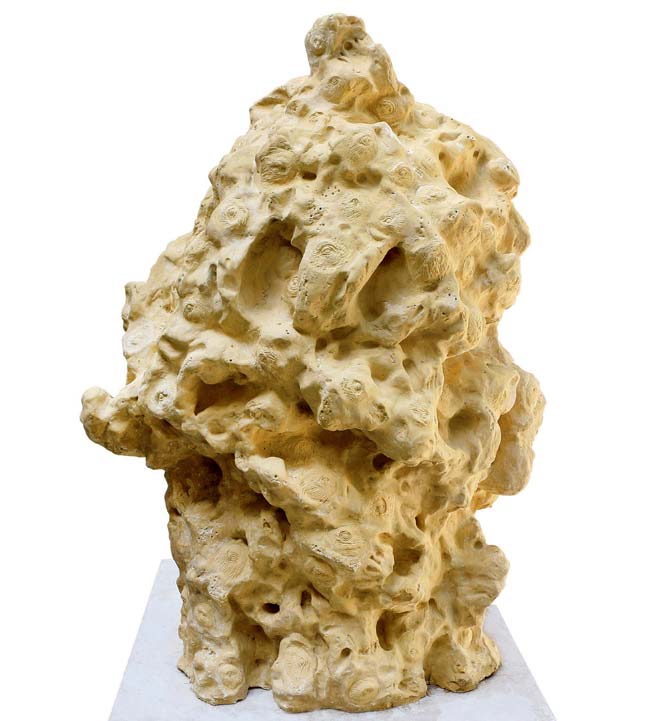Ahead of his first solo showcase in Brussels, Jitish Kallat shares his fascination with the idea of time, and a new body of works that includes anthill sculptures


Jitish Kallat flanked by drawings that are part of Wind Study (Hilbert Space), 2017, burnt adhesive, aquarelle pencil and graphite on paper. Pics/Datta Kumbhar
ADVERTISEMENT
A drawing at Jitish Kallat's studio in Bandra resembles a maze created with thread-like lines embossed by shadows that offer a 3D effect. The shadows are actually marks left behind by fumes, when the lines are set aflame with a liquid. The wind direction during the moment of combustion determines the mark's shape. "The drawing thus becomes a device to read the complex forces of nature that inhabit the space and time of the artwork" reads the artist's working notation.

Sacred Geometry (Covariance), 2017, dental plaster. Pic courtesy/Jitish Kallat
In his latest solo, Covariance, Kallat probes the ideas of time, sustenance and sleep, along with an interplay of scales and proximities — themes visible in many of his previous works. The exhibition, which will be showcased at Gallerie Daniel Templon in Brussels this September, marks Kallat's first solo in the Belgian capital. It comes close on the heels of his mid-career retrospective, Here After Here, held earlier this year in New Delhi. "That brought together 25 years of my work. There were many revelations in the process of making the show. I'd say, it was a 'retro-prospective'… looking back to look ahead," he articulates.

Postulates (three-fold drawings), 2017, mixed-media and collage on paper
On his fascination with time, Kallat shares, "Time is one of the several unknowns that make up our lived reality. Ordinarily, what we think of as time is periodicity. But there is an unchanging dimension to time, which can be experienced at an individual level. But, even to point towards it, one has to return to familiar ideas of duration and transience."
The exhibition features a collection of large format works on paper, titled Wind Study - Hilbert Curve (The Hour of the Day of the Month of the Season). They derive their form from the clusters of geometric curves first described by the German mathematician David Hilbert in 1891.
The show includes two anthill-like sculptures titled Covariance. They feature a number of tiny eyes, modelled on those of different animal species, reflecting Kallat's fascination with the way they look at the world.
Another detailed sculpture shows 13 vertebrates sleeping on an undulating terrain. An ancient Peruvian solar observatory, propped with thirteen mounds forming a toothed horizon, inspires it. The exhibition also features a bunch of three-fold exploratory drawings titled Postulates. So, is it expected to travel to Mumbai? "No. There is an elaborate 400-page book covering my life-work, which will be released in Mumbai early next year," he sums up before shipping off the last of the pieces to Brussels.
 Subscribe today by clicking the link and stay updated with the latest news!" Click here!
Subscribe today by clicking the link and stay updated with the latest news!" Click here!






